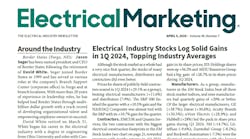The push to coordinate baseline energy efficiency standards for commercial buildings nationwide came to some fruition last month with the establishment of a new national energy standard. The impact will be felt in cities throughout the United States and contractors, builders, and the manufacturers, reps and distributors who supply them will be rushing to get up to speed on the latest requirements.
On Oct. 18, all states were required by the U.S. Department of Energy (DOE) to put in place a commercial building energy code at least as stringent as the 2010 version of the ASHRAE/IES 90.1 energy standard.
One of the primary areas of interest to the electrical industry is the impact on building energy control systems, and lighting controls in particular. The new 2010 standard is much more detailed and stringent than its predecessor, featuring stricter lighting power densities and much stronger mandatory lighting control requirements, said Craig DiLouie in an article for the Lighting Controls Association. “Additionally, commissioning elements including design documentation and functional testing must be provided. Retrofit projects in which 10%-plus of the connected lighting load is replaced must satisfy the standard’s lighting power and automatic shutoff provisions.”
Electrical manufacturers are finding creative solutions for addressing the change to the new standard. Hubbell Wiring Device-Kellems, Shelton, Conn., and Lutron Electronics, Coopersburg, Pa., for example, announced that they will collaborate on development of new products that will enable the electrical industry to better comply with new building code requirements for controlling electrical outlets and their associated plug loads, the companies said in a joint statement.
Hubbell will embed Lutron’s Clear Connect radio frequency (RF) communication technology directly into Hubbell’s Load:Logic plug load control products. The deal expands the interoperability of Clear Connect-enabled devices, provides the industry with a much-needed, code-compliant solution, and allows installers and users to control electrical outlets in new and existing facilities without learning new systems or performing extensive commissioning.
The use of automated controls for lighting and HVAC has dramatically increased efficiencies of these systems in modern facilities, said the Hubbell-Lutron release. In contrast, miscellaneous plug loads connected to electrical receptacles have been left uncontrolled and can now approach 50% of a high performance building’s energy footprint. To address this, ASHRAE 90.1-2010, California Energy Commission, and LEED v4 require that 50% of power outlets must be controlled in most areas of a building.
Other requirements of the new minimum standard specify daylighting controls in projects larger than 50,000 square feet, widespread use of occupancy sensors and automatic shut-offs, and functional testing of controls.








